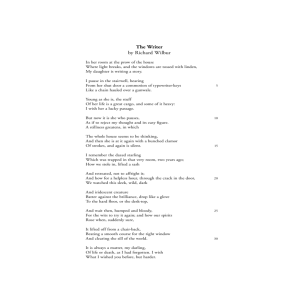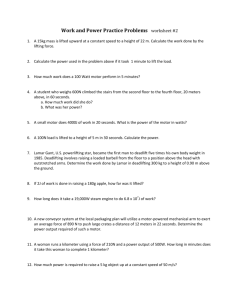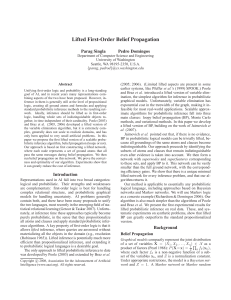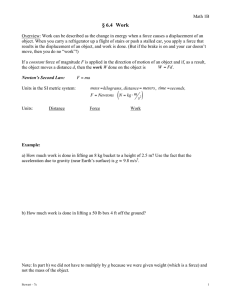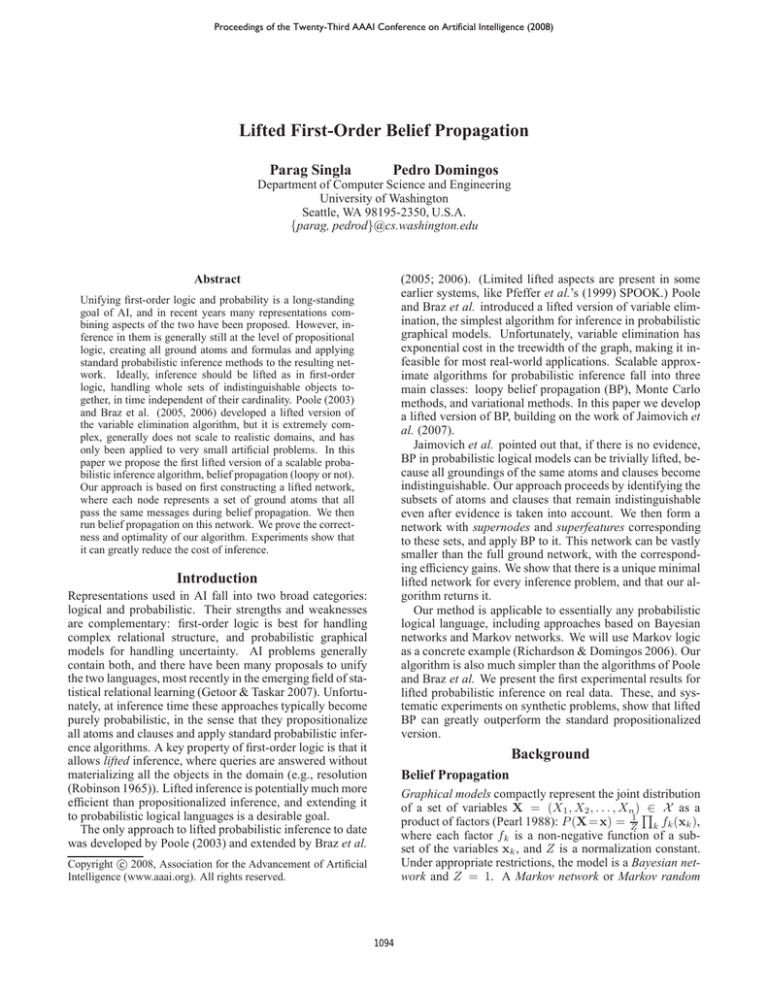
Proceedings of the Twenty-Third AAAI Conference on Artificial Intelligence (2008)
Lifted First-Order Belief Propagation
Parag Singla
Pedro Domingos
Department of Computer Science and Engineering
University of Washington
Seattle, WA 98195-2350, U.S.A.
{parag, pedrod}@cs.washington.edu
(2005; 2006). (Limited lifted aspects are present in some
earlier systems, like Pfeffer et al.’s (1999) SPOOK.) Poole
and Braz et al. introduced a lifted version of variable elimination, the simplest algorithm for inference in probabilistic
graphical models. Unfortunately, variable elimination has
exponential cost in the treewidth of the graph, making it infeasible for most real-world applications. Scalable approximate algorithms for probabilistic inference fall into three
main classes: loopy belief propagation (BP), Monte Carlo
methods, and variational methods. In this paper we develop
a lifted version of BP, building on the work of Jaimovich et
al. (2007).
Jaimovich et al. pointed out that, if there is no evidence,
BP in probabilistic logical models can be trivially lifted, because all groundings of the same atoms and clauses become
indistinguishable. Our approach proceeds by identifying the
subsets of atoms and clauses that remain indistinguishable
even after evidence is taken into account. We then form a
network with supernodes and superfeatures corresponding
to these sets, and apply BP to it. This network can be vastly
smaller than the full ground network, with the corresponding efficiency gains. We show that there is a unique minimal
lifted network for every inference problem, and that our algorithm returns it.
Our method is applicable to essentially any probabilistic
logical language, including approaches based on Bayesian
networks and Markov networks. We will use Markov logic
as a concrete example (Richardson & Domingos 2006). Our
algorithm is also much simpler than the algorithms of Poole
and Braz et al. We present the first experimental results for
lifted probabilistic inference on real data. These, and systematic experiments on synthetic problems, show that lifted
BP can greatly outperform the standard propositionalized
version.
Abstract
Unifying first-order logic and probability is a long-standing
goal of AI, and in recent years many representations combining aspects of the two have been proposed. However, inference in them is generally still at the level of propositional
logic, creating all ground atoms and formulas and applying
standard probabilistic inference methods to the resulting network. Ideally, inference should be lifted as in first-order
logic, handling whole sets of indistinguishable objects together, in time independent of their cardinality. Poole (2003)
and Braz et al. (2005, 2006) developed a lifted version of
the variable elimination algorithm, but it is extremely complex, generally does not scale to realistic domains, and has
only been applied to very small artificial problems. In this
paper we propose the first lifted version of a scalable probabilistic inference algorithm, belief propagation (loopy or not).
Our approach is based on first constructing a lifted network,
where each node represents a set of ground atoms that all
pass the same messages during belief propagation. We then
run belief propagation on this network. We prove the correctness and optimality of our algorithm. Experiments show that
it can greatly reduce the cost of inference.
Introduction
Representations used in AI fall into two broad categories:
logical and probabilistic. Their strengths and weaknesses
are complementary: first-order logic is best for handling
complex relational structure, and probabilistic graphical
models for handling uncertainty. AI problems generally
contain both, and there have been many proposals to unify
the two languages, most recently in the emerging field of statistical relational learning (Getoor & Taskar 2007). Unfortunately, at inference time these approaches typically become
purely probabilistic, in the sense that they propositionalize
all atoms and clauses and apply standard probabilistic inference algorithms. A key property of first-order logic is that it
allows lifted inference, where queries are answered without
materializing all the objects in the domain (e.g., resolution
(Robinson 1965)). Lifted inference is potentially much more
efficient than propositionalized inference, and extending it
to probabilistic logical languages is a desirable goal.
The only approach to lifted probabilistic inference to date
was developed by Poole (2003) and extended by Braz et al.
Background
Belief Propagation
Graphical models compactly represent the joint distribution
of a set of variables X = (X1 , X2 , . . . , Xn ) Q∈ X as a
product of factors (Pearl 1988): P (X = x) = Z1 k fk (xk ),
where each factor fk is a non-negative function of a subset of the variables xk , and Z is a normalization constant.
Under appropriate restrictions, the model is a Bayesian network and Z = 1. A Markov network or Markov random
c 2008, Association for the Advancement of Artificial
Copyright Intelligence (www.aaai.org). All rights reserved.
1094
Table 1: Example of a Markov logic network. Free variables are implicitly universally quantified.
English
Most people don’t smoke.
Most people don’t have cancer.
Most people aren’t friends.
Smoking causes cancer.
Friends have similar smoking habits.
First-Order Logic
¬Smokes(x)
¬Cancer(x)
¬Friends(x, y)
Smokes(x) ⇒ Cancer(x)
Smokes(x) ∧ Friends(x, y) ⇒ Smokes(y)
field can have arbitrary factors. As long as P (X = x) > 0
for all x, the distribution can be equivalently
P represented as a
log-linear model: P (X = x) = Z1 exp ( i wi gi (x)), where
the features gi (x) are arbitrary functions of (a subset of) the
state.
Graphical models can be represented as factor graphs
(Kschischang, Frey, & Loeliger 2001). A factor graph is
a bipartite graph with a node for each variable and factor in
the model. (For convenience, we will consider one factor
fi (x) = exp(wi gi (x)) per feature gi (x), i.e., we will not
aggregate features over the same variables into a single factor.) Variables and the factors they appear in are connected
by undirected edges.
The main inference task in graphical models is to compute
the conditional probability of some variables (the query)
given the values of some others (the evidence), by summing
out the remaining variables. This problem is #P-complete,
but becomes tractable if the graph is a tree. In this case, the
marginal probabilities of the query variables can be computed in polynomial time by belief propagation, which consists of passing messages from variable nodes to the corresponding factor nodes and vice-versa. The message from a
variable x to a factor f is
Y
µx→f (x) =
µh→x (x)
(1)
Belief propagation can also be used for exact inference in
arbitrary graphs, by combining nodes until a tree is obtained,
but this suffers from the same combinatorial explosion as
variable elimination.
Markov Logic
First-order probabilistic languages combine graphical models with elements of first-order logic, by defining template
features that apply to whole classes of objects at once.
A simple and powerful such language is Markov logic
(Richardson & Domingos 2006). A Markov logic network
(MLN) is a set of weighted first-order clauses.1 Together
with a set of constants representing objects in the domain
of interest, it defines a Markov network with one node per
ground atom and one feature per ground clause. The weight
of a feature is the weight of the first-order clause that originated it. The probability of P
a state x in such aQnetwork
is given by P (x) = Z1 exp ( i wi gi (x)) = Z1 i fi (x),
where wi is the weight of the ith clause, gi = 1 if the ith
clause is true, and gi = 0 otherwise. Table 1 shows an example of a simple MLN representing a standard social network model. In a domain with two objects Anna and Bob,
ground atoms will include Smokes(Anna), Cancer(Bob),
Friends(Anna, Bob), etc. States of the world where more
smokers have cancer, and more pairs of friends have similar
smoking habits, are more probable.
Inference in Markov logic can be carried out by creating the ground network and applying belief propagation to
it, but this can be extremely inefficient because the size of
the ground network is O(dc ), where d is the number of objects in the domain and c is the highest clause arity. In the
next section we introduce a better, lifted algorithm for inference. Although we focus on Markov logic for simplicity,
the algorithm is easily generalized to other representations.
Alternatively, they can be translated to Markov logic and the
algorithm applied directly (Richardson & Domingos 2006).
h∈nb(x)\{f }
where nb(x) is the set of factors x appears in. The message
from a factor to a variable is
X
Y
f (x)
µy→f (y)
(2)
µf →x (x) =
∼{x}
Weight
1.4
2.3
4.6
1.5
1.1
y∈nb(f )\{x}
where nb(f ) are the arguments of f , and the sum is over
all of these except x. The messages from leaf variables are
initialized to 1, and a pass from the leaves to the root and
back to the leaves suffices. The (unnormalized)
marginal of
Q
each variable x is then given by h∈nb(x) µh→x (x). Evidence is incorporated by setting f (x) = 0 for states x that
are incompatible with it. This algorithm can still be applied
when the graph has loops, repeating the message-passing
until convergence. Although this loopy belief propagation
has no guarantees of convergence or of giving the correct result, in practice it often does, and can be much more efficient
than other methods. Different schedules may be used for
message-passing. Here we assume flooding, the most widely
used and generally best-performing method, in which messages are passed from each variable to each corresponding
factor and back at each step (after initializing all variable
messages to 1).
Lifted Belief Propagation
We begin with some necessary definitions. These assume
the existence of an MLN M, set of constants C, and evidence database E (set of ground literals). For simplicity,
our definitions and explanation of the algorithm will assume
that each predicate appears at most once in any given MLN
clause. We will then describe how to handle multiple occurrences of a predicate in a clause.
Definition 1 A supernode is a set of groundings of a predicate that all send and receive the same messages at each step
1
In this paper we assume function-free clauses and Herbrand
interpretations.
1095
of belief propagation, given M, C and E. The supernodes
of a predicate form a partition of its groundings.
A superfeature is a set of groundings of a clause that all
send and receive the same messages at each step of belief
propagation, given M, C and E. The superfeatures of a
clause form a partition of its groundings.
Definition 2 A lifted network is a factor graph composed of
supernodes and superfeatures. The factor corresponding to
a superfeature g(x) is exp(wg(x)), where w is the weight
of the corresponding first-order clause. A supernode and a
superfeature have an edge between them iff some ground
atom in the supernode appears in some ground clause in the
superfeature. Each edge has a positive integer weight. A
minimal lifted network is a lifted network with the smallest
possible number of supernodes and superfeatures.
The first step of lifted BP is to construct the minimal lifted
network. The size of this network is O(nm), where n is the
number of supernodes and m the number of superfeatures.
In the best case, the lifted network has the same size as the
MLN; in the worst case, as the ground Markov network.
The second and final step in lifted BP is to apply standard
BP to the lifted network, with two changes:
1. The message from supernode x to superfeature f becomes
n(f,x)−1 Q
n(h,x)
µf →x
, where n(h, x) is
h∈nb(x)\{f } µh→x (x)
the weight of the edge between h and x.
2. The (unnormalized) marginal of each supernode (and
therefore of each ground atom in it) is given by
Q
n(h,x)
h∈nb(x) µh→x (x).
Table 2: Lifted network construction.
function LNC(M, C, E)
inputs: M, a Markov logic network
C, a set of constants
E, a set of ground literals
output: L, a lifted network
for each predicate P
for each truth value t in {true, false, unknown}
form a supernode containing all groundings of P
with truth value t
repeat
for each clause C involving predicates P1 , . . . , Pk
for each tuple of supernodes (N1 , . . . , Nk ),
where Ni is a Pi supernode
form a superfeature F by joining N1 , . . . , Nk
for each predicate P
for each superfeature F it appears in
S(P, F ) ← projection of the tuples in F down to
the variables in P
for each tuple s in S(P, F )
T (s, F ) ← number of F ’s tuples that were
projected
into s
S
S(P ) ← F S(P, F )
form a new supernode from each set of tuples in S(P )
with the same T (s, F ) counts for all F
until convergence
add all current supernodes and superfeatures to L
for each supernode N and superfeature F in L
add to L an edge between N and F with weight T (s, F )
return L
The weight of an edge is the number of identical messages
that would be sent from the ground clauses in the superfeature to each ground atom in the supernode if BP was carried
out on the ground network. The n(f, x) − 1 exponent reflects the fact that a variable’s message to a factor excludes
the factor’s message to the variable.
The lifted network is constructed by (essentially) simulating BP and keeping track of which ground atoms and clauses
send the same messages. Initially, the groundings of each
predicate fall into three groups: known true, known false
and unknown. (One or two of these may be empty.) Each
such group constitutes an initial supernode. All groundings
of a clause whose atoms have the same combination of truth
values (true, false or unknown) now send the same messages
to the ground atoms in them. In turn, all ground atoms that
receive the same number of messages from the superfeatures
they appear in send the same messages, and constitute a new
supernode. As the effect of the evidence propagates through
the network, finer and finer supernodes and superfeatures are
created.
If a clause involves predicates R1 , . . . , Rk , and N =
(N1 , . . . , Nk ) is a corresponding tuple of supernodes, the
groundings of the clause generated by N are found by joining N1 , . . . , Nk (i.e., by forming the Cartesian product of
the relations N1 , . . . , Nk , and selecting the tuples in which
the corresponding arguments agree with each other, and with
any corresponding constants in the first-order clause). Conversely, the groundings of predicate Ri connected to elements of a superfeature F are obtained by projecting F onto
the arguments it shares with Ri . Lifted network construction
thus proceeds by alternating between two steps:
1. Form superfeatures by doing joins of their supernodes.
2. Form supernodes by projecting superfeatures down to
their predicates, and merging atoms with the same projection counts.
Pseudo-code for the algorithm is shown in Table 2. The
projection counts at convergence are the weights associated
with the corresponding edges.
To handle clauses with multiple occurrences of a predicate, we keep a tuple of edge weights, one for each occurrence of the predicate in the clause. A message is passed
for each occurrence of the predicate, with the corresponding
edge weight. Similarly, when projecting superfeatures into
supernodes, a separate count is maintained for each occurrence, and only tuples with the same counts for all occurrences are merged.
Theorem 1 Given an MLN M, set of constants C and set
of ground literals E, there exists a unique minimal lifted network L∗ , and algorithm LNC(M, C, E) returns it. Belief
propagation applied to L∗ produces the same results as belief propagation applied to the ground Markov network generated by M and C.
Proof. We prove each part in turn.
1096
The uniqueness of L∗ is proved by contradiction. Suppose there are two minimal lifted networks L1 and L2 . Then
there exists a ground atom a that is in supernode N1 in L1
and in supernode N2 in L2 , and N1 6= N2 ; or similarly for
some superfeature c. Then, by Definition 1, all nodes in N1
send the same messages as a and so do all nodes in N2 , and
therefore N1 = N2 , resulting in a contradiction. A similar
argument applies to c. Therefore there is a unique minimal
lifted network L∗ .
We now show that LNC returns L∗ in two subparts:
1. The network Li obtained by LNC at any iteration i is no
finer than L∗ in the sense that, if two ground atoms are
in different supernodes in Li , they are in different supernodes in L∗ , and similarly for ground clauses.
2. LNC converges in a finite number of iterations to a network L where all ground atoms (ground clauses) in a supernode (superfeature) receive the same messages during
ground BP.
The claim follows immediately from these two statements,
since if L is no finer than L∗ and no coarser, it must be L∗ .
For subpart 1, it is easy to see that if it is satisfied by
the atoms at the ith iteration, then it is also satisfied by
the clauses at the ith iteration. Now, we will prove subpart 1 by induction. Clearly, it is true at the start of the
first iteration. Suppose that a supernode N splits into N1
and N2 at the ith iteration. Let a1 ∈ N1 and a2 ∈ N2 .
Then there must be a superfeature F in the ith iteration such
∗
that T (a1 , F ) 6= T (a2 , F ). Since Li is no finer than
S L ,
∗
there exist superfeatures Fj in L such that F = j Fj .
Since T (a1 , F ) 6= T (a2 , F ), ∃j T (a1 , Fj ) 6= T (a2 , Fj ),
and therefore a1 and a2 are in different supernodes in L∗ .
Hence Li+1 is no finer than L∗ , and by induction this is true
at every iteration.
We prove subpart 2 as follows. In the first iteration each
supernode either remains unchanged or splits into finer supernodes, because each initial supernode is as large as possible. In any iteration, if each supernode remains unchanged
or splits into finer supernodes, each superfeature also remains unchanged or splits into finer superfeatures, because
splitting a supernode that is joined into a superfeature necessarily causes the superfeature to be split as well. Similarly, if each superfeature remains unchanged or splits into
finer superfeatures, each supernode also remains unchanged
or splits into finer supernodes, because (a) if two nodes are
in different supernodes they must have different counts from
at least one superfeature, and (b) if two nodes have different
counts from a superfeature, they must have different counts
from at least one of the finer superfeatures that it splits into,
and therefore must be assigned to different supernodes.
Therefore, throughout the algorithm supernodes and superfeatures can only remain unchanged or split into finer
ones. Because there is a maximum possible number of supernodes and superfeatures, this also implies that the algorithm converges in a finite number of iterations. Further, no
splits occur iff all atoms in each supernode have the same
counts as in the previous iteration, which implies they receive the same messages at every iteration, and so do all
clauses in each corresponding superfeature.
The proof that BP applied to L gives the same results as
BP applied to the ground network follows from Definitions 1
and 2, the previous parts of the theorem, modifications 1 and
2 to the BP algorithm, and the fact that the number of identical messages sent from the ground atoms in a superfeature
to each ground atom in a supernode is the cardinality of the
projection of the superfeature onto the supernode. 2
Clauses involving evidence atoms can be simplified (false
literals and clauses containing true literals can be deleted).
As a result, duplicate clauses may appear, and the corresponding superfeatures can be merged. This will typically
result in duplicate instances of tuples. Each
P tuple in the
merged superfeature is assigned a weight i mi wi , where
mi is the number of duplicate tuples resulting from the ith
superfeature and wi is the corresponding weight. During
the creation of supernodes, T (s, F ) is now the number of
F tuples projecting into s multiplied by the corresponding
weight. This can greatly reduce the size of the lifted network. When no evidence is present, our algorithm reduces
to the one proposed by Jaimovich et al. (2007).
An important question remains: how to represent supernodes and superfeatures. Although this does not affect the
space or time cost of belief propagation (where each supernode and superfeature is represented by a single symbol), it
can greatly affect the cost of constructing the lifted network.
The simplest option is to represent each supernode or superfeature extensionally as a set of tuples (i.e., a relation), in
which case joins and projections reduce to standard database
operations. However, in this case the cost of constructing
the lifted network is similar to the cost of constructing the
full ground network, and can easily become the bottleneck.
A better option is to use a more compact intensional representation, as done by Poole (2003) and Braz et al. (2005;
2006).2
A ground atom can be viewed as a first-order atom with
all variables constrained to be equal to constants, and similarly for ground clauses. (For example, R(A, B) is R(x, y)
with x = A and y = B.) We represent supernodes by sets of
(α, γ) pairs, where α is a first-order atom and γ is a set of
constraints, and similarly for superfeatures. Constraints are
of the form x = y or x 6= y, where x is an argument of the
atom and y is either a constant or another argument. For example, (S(v, w, x, y, z), {w = x, y = A, z 6= B, z 6= C}) compactly represents all groundings of S(v, w, x, y, z) compatible with the constraints. Notice that variables may be left
unconstrained, and that infinite sets of atoms can be finitely
represented in this way.
Let the default value of a predicate R be its most frequent
value given the evidence (true, false or unknown). Let SR,i
be the set of constants that appear as the ith argument of R
only in groundings with the default value. Supernodes not
involving any members of SR,i for any argument i are represented extensionally (i.e. with pairs (α, γ) where γ contains
2
Superfeatures are related, but not identical, to the parfactors of
Poole and Braz et al.. One important difference is that superfeatures correspond to factors in the original graph, while parfactors
correspond to factors created during variable elimination. Superfeatures are thus exponentially more compact.
1097
a constraint of the form x = A, where A is a constant, for
each argument x). Initially, supernodes involving members
of SR,i are represented using (α, γ) pairs containing constraints of the form x 6= A for each A ∈ C \ SR,i .3 When
two or more supernodes are joined to form a superfeature F ,
if the kth argument of
T F ’s clause is the i(j)th argument of
its jth literal, Sk = j Sr(j),i , where r(j) is the predicate
symbol in the jth literal. F is now represented analogously
to the supernodes, according to whether or not it involves elements of Sk . If F is represented intensionally, each (α, γ)
pair is divided into one pair for each possible combination
of equality/inequality constraints among the clause’s arguments, which are added to γ. When forming a supernode
from superfeatures, the constraints in each (α, γ) pair in the
supernode are the union of (a) the corresponding constraints
in the superfeatures on the variables included in the supernode, and (b) the constraints induced by the excluded variables on the included ones. This process is analogous to the
shattering process of Braz et al. (2005).
In general, finding the most compact representation for
supernodes and superfeatures is an intractable problem. Investigating it further is a direction for future work.
Link Prediction
Link prediction is an important problem with many applications: social network analysis, law enforcement,
bibliometrics, identifying metabolic networks in cells,
etc. We experimented on the link prediction task of
Richardson and Domingos (2006), using the UW-CSE
database and MLN publicly available from the Alchemy
website (Kok et al. 2007). The database contains a total
of 2678 groundings of predicates like: Student(person),
Professor(person), AdvisedBy(person1, person2),
TaughtBy(course, person, quarter),
Publication
(paper, person) etc. The MLN includes 94 formulas
stating regularities like: each student has at most one advisor; if a student is an author of a paper, so is her advisor;
etc. The task is to predict who is whose advisor, i.e., the
AdvisedBy(x, y) predicate, from information about paper
authorships, classes taught, etc. The database is divided into
five areas (AI, graphics, etc.); we trained weights on the
smallest using Alchemy’s default discriminative learning
algorithm, ran inference on all five, and averaged the results.
Social Networks
We compared the performance of lifted BP with the ground
version on three domains. All the domains are loopy (i.e.,
the graphs have cycles), and the algorithms of Poole (2003)
and Braz et al. (2005; 2006) run out of memory, rendering
them inapplicable. We implemented lifted BP as an extension of the open-source Alchemy system (Kok et al. 2007).
Since our algorithm is guaranteed to produce the same results as the ground version, we do not report solution quality.
Diagnosing the convergence of BP is a difficult problem; we
ran it for 1000 steps for both algorithms in all experiments.
BP did not always converge. Either way, it was marginally
less accurate than Gibbs sampling. The experiments were
run on a cluster of nodes, each node having 3.46 GB of RAM
and two processors running at 3 GHz.
We also experimented with the example “Friends & Smokers” MLN in Table 1. The goal here was to examine how
the relative performance of lifted BP and ground BP varies
with the number of objects in the domain and the fraction of
objects we have evidence about. We varied the number of
people from 250 to 2500 in increments of 250, and the fraction of known people KF from 0 to 1. A KF of r means
that we know for a randomly chosen r fraction of all people (a) whether they smoke or not and (b) who 10 of their
friends are (other friendship relations are still assumed to be
unknown). Cancer(x) is unknown for all x. The people
with known information were randomly chosen. The whole
domain was divided into a set of friendship clusters of size
50 each. For each known person, we randomly chose each
friend with equal probability of being inside or outside their
friendship cluster. All unknown atoms were queried.
Entity Resolution
Results
Entity resolution is the problem of determining which observations (e.g., records in a database) correspond to the
same objects. This problem is of crucial importance to many
large scientific projects, businesses, and government agencies, and has received increasing attention in the AI community in recent years. We used the version of McCallum’s
Cora database available on the Alchemy website (Kok et al.
2007). The inference task was to de-duplicate citations, authors and venues (i.e., to determine which pairs of citations
refer to the same underlying paper, and similarly for author
fields and venue fields). We used the MLN (formulas and
weights) used by Singla and Domingos (2005) in their experiments. This contains 46 first-order clauses stating regularities such as: if two fields have high TF-IDF similarity,
they are (probably) the same; if two records are the same,
their fields are the same, and vice-versa; etc.
Results on all domains are summarized in Table 3. The
Friends & Smokers results are for 1000 people and KF =
0.1; the Cora results are for 500 records. All results for
Cora and Friends & Smokers are averages over five random
splits. 4 LNC with intensional representation is comparable
in time and memory with the extensional version on Cora
and UW-CSE, but much more efficient on Friends & Smokers. All the results shown are for the intensional representation. LNC is slower than grounding the full network, but BP
is much faster on the lifted network, resulting in better times
in all domains (by two orders of magnitude on Friends &
Smokers). The number of (super) features created is much
smaller for lifted BP than for ground BP (by four orders of
magnitude on Friends & Smokers). Memory (not reported
here) is comparable on Cora and UW-CSE, and much lower
for LNC on Friends & Smokers. Figure 1 shows how network size varies with the number of people in the Friends
Experiments
3
In practice, variables are typed, and C is replaced by the domain of the argument; and the set of constraints is only stored once,
and pointed to as needed.
4
For Cora, we made sure that each actual cluster was either
completely inside or outside each split.
1098
Table 3: Time and memory cost of ground and lifted BP.
Domain
Cora
UW-CSE
Friends & Smokers
Construction
Ground Lifted
263.1 1173.3
6.9
22.1
38.8
89.7
Time (in seconds)
BP
Total
Ground Lifted Ground Lifted
12368.4 3997.7 12631.6 5171.1
1015.8
602.5
1022.8
624.7
10702.2
4.4 10741.0
94.2
Ground
2078629
217665
1900905
Lifted
295468
86459
58
Acknowledgments
1e+07
No. of (Super) Features
No. of (Super) Features
This research was funded by DARPA contracts NBCHD030010/02-000225, FA8750-07-D-0185, and HR0011-07-C0060, DARPA grant FA8750-05-2-0283, NSF grant IIS-0534881,
and ONR grant N-00014-05-1-0313. The views and conclusions
contained in this document are those of the authors and should not
be interpreted as necessarily representing the official policies, either expressed or implied, of DARPA, NSF, ONR, or the United
States Government.
1e+06
100000
10000
1000
References
100
10
de S. Braz, R.; Amir, E.; and Roth, D. 2005. Lifted first-order
probabilistic inference. In Proc. IJCAI-05, 1319–1324.
de S. Braz, R.; Amir, E.; and Roth, D. 2006. MPE and partial inversion in lifted probabilistic variable elimination. In Proc.
AAAI-06, 1123–1130.
Getoor, L., and Taskar, B., eds. 2007. Introduction to Statistical
Relational Learning. MIT Press.
Jaimovich, A.; Meshi, O.; and Friedman, N. 2007. Template
based inference in symmetric relational Markov random fields.
In Proc. UAI-07, 191–199.
Kok, S.; Sumner, M.; Richardson, M.; Singla, P.; Poon, H.; Lowd,
D; and Domingos, P. 2007. The Alchemy system for statistical
relational AI. Tech. Rept., Dept. Comp. Sci.& Eng., Univ. Washington, Seattle, WA. http://alchemy.cs.washington.edu.
Kschischang, F. R.; Frey, B. J.; and Loeliger, H.-A. 2001. Factor
graphs and the sum-product algorithm. IEEE Transactions on
Information Theory 47:498–519.
Pearl, J. 1988. Probabilistic Reasoning in Intelligent Systems:
Networks of Plausible Inference. Morgan Kaufmann.
Pfeffer, A.; Koller, D.; Milch, B.; and Takusagawa, K. T. 1999.
Spook: A system for probabilistic object-oriented knowledge representation. In Proc. UAI-99, 541–550.
Poole, D. 2003. First-order probabilistic inference. In Proc.
IJCAI-03, 985–991.
Richardson, M., and Domingos, P. 2006. Markov logic networks.
Machine Learning 62:107–136.
Robinson, J. A. 1965. A machine-oriented logic based on the
resolution principle. Journal of the ACM 12:23–41.
Singla, P., and Domingos, P. 2005. Discriminative training of
Markov logic networks. In Proc. AAAI-05, 868–873.
Singla, P., and Domingos, P. 2006. Memory-efficient inference
in relational domains. In Proc. AAAI-06, 488–493.
Singla, P., and Domingos, P. 2007. Markov logic in infinite domains. In Proc. UAI-07, 368–375.
Wellman, M.; Breese, J. S.; and Goldman, R. P. 1992. From
knowledge bases to decision models. Knowledge Engineering
Review 7.
Ground
Lifted
1
0
500
1000
1500
2000
2500
No. of Objects
Figure 1: Growth of network size on Friends & Smokers
domain.
& Smokers domain, for KF = 0.1. The lifted network is
always much smaller, and the difference increases markedly
with the number of objects (note the logarithmic scale on
the Y axis). The ground version ran out of memory for more
than 1500 people. We also varied KF while keeping the
number of people constant at 1000 (results not shown due to
lack of space). The lifted network is always smaller than the
ground one by at least four orders of magnitude, rising to six
for extreme values of KF .
Conclusion and Future Work
We presented the first scalable algorithm for lifted probabilistic inference, and the first application of these to realworld domains. Our algorithm constructs a network of supernodes and superfeatures, corresponding to sets of nodes
and features that are indistiguishable given the evidence, and
applies belief propagation to this network. Our experiments
illustrate the efficiency gains obtainable by this method.
Directions for future work include: clustering atoms to
further compress the representation of supernodes; merging nodes that pass approximately the same messages; generalizing our approach to other inference methods (e.g.,
MCMC) and tasks (e.g., MPE); fully unifying lifted BP and
resolution; applying lifted BP to infinite domains (Singla &
Domingos 2007); extending lifted BP to subsume lazy inference (Singla & Domingos 2006) and knowledge-based
model construction (Wellman et al. 1992); using lifted BP
in learning; applying it to other domains; etc.
1099

